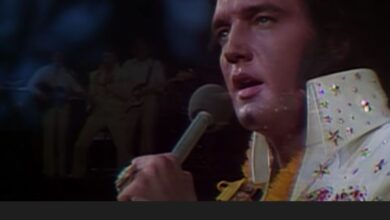Pleased That This Elvis Performance Is Accessible; A Piece Of History Many Might Have Missed
“Blue Suede Shoes” emerged in the mid-1950s, during a transformative period in American music history where traditional genres were blending and evolving into new forms. Written and first performed by Carl Perkins, the song captures a sense of youthful rebellion and style, representing a new cultural phenomenon that was taking shape. Perkins himself was influenced by the rhythm and blues traditions of the time, which can be heard in the driving rhythm and lively melody of the song.
Carl Perkins recorded “Blue Suede Shoes” in 1955, and it was initially released on the Sun Records label. Its catchy chorus and rockabilly feel resonated with audiences, and the song quickly became a regional hit. However, it was Elvis Presley’s electrifying cover that turned “Blue Suede Shoes” into a national sensation. Released as part of his debut album, “Elvis Presley,” in 1956, Elvis’s rendition infused the original with his unique vocal style and charisma, propelling it to new heights of popularity.
Elvis Presley, often hailed as the ‘King of Rock and Roll,’ was born in Tupelo, Mississippi, in 1935. His upbringing in a modest household surrounded by gospel and blues music laid the foundation for his eclectic sound. By the time of his cover in 1956, Elvis had already begun to revolutionize popular music, merging various influences into a distinctive style that appealed to a broad audience. His charisma, good looks, and energetic performances made him a cultural icon almost overnight.
In Elvis’s version of “Blue Suede Shoes,” the singer’s confidence and defiance shine through the lyrics. The repeated refrain serves as both a warning and a declaration of ownership over this prized possession. The blue suede shoes, a symbol of style and coolness, represent more than just footwear; they signify an attitude, a way of being that was emblematic of the youth culture at the time. Elvis’s delivery, marked by his dynamic vocal inflections, managed to convey a sense of urgency and excitement that resonated with fans.
The song’s infectious beat is another crucial element that contributed to its success. The combination of Perkins’s original rockabilly sound and Elvis’s rhythm-and-blues influences created a captivating groove that invited listeners to dance. During a period when rock and roll was rapidly gaining popularity, songs like “Blue Suede Shoes” played a pivotal role in defining the sound of the era. Its influence can still be felt in contemporary music, as many artists draw from the foundations laid by early rock and roll pioneers.
Elvis’s cover of “Blue Suede Shoes” reached significant commercial success, peaking at number 20 on the Billboard Hot 100 chart. It helped pave the way for the rock and roll movement, leading to the rise of other Rock icons. His electrifying performances on stage, paired with the vibrant sound of the song, helped to establish a new form of entertainment that captivated audiences. Television appearances, concert tours, and radio play all contributed to the song’s enduring popularity.
Beyond its immediate success, “Blue Suede Shoes” has been covered by numerous artists across various genres, further embedding it in the fabric of American music. Notable renditions include those by the likes of Johnny Rivers, who infused it with a more pop-oriented sound, and even modern rock bands who recognize its historical significance. These covers often demonstrate the song’s versatility and its ability to adapt to different musical contexts while still retaining its original charm.
The cultural impact of “Blue Suede Shoes” also extends beyond music. The song has been referenced in various media, including films, television shows, and commercials, attesting to its lasting relevance. It serves as a cultural touchstone, evoking memories of a time when youth culture was evolving and rock and roll was asserting itself as a dominant force in popular entertainment.
Today, “Blue Suede Shoes” occupies an important place in rock and roll history, symbolizing the rebellious spirit of the 1950s. Elvis’s interpretation crystallized its status as a classic, and it continues to be celebrated at music festivals, retro events, and concert tours dedicated to rock and roll. The song’s legacy is a testament to the power of music to transcend time and influence generations.
As a significant piece in Elvis Presley’s extensive catalog, “Blue Suede Shoes” reflects his broader impact on the music industry. With his groundbreaking style and interaction with contemporary songwriters and musicians, Elvis played a crucial role in shaping rock and roll. His ability to take a compelling song and elevate it to iconic status is part of what sets him apart as one of the most influential figures in music history. The vibrancy and energy he brought to “Blue Suede Shoes” remain a hallmark of his enduring legacy as a performer.



